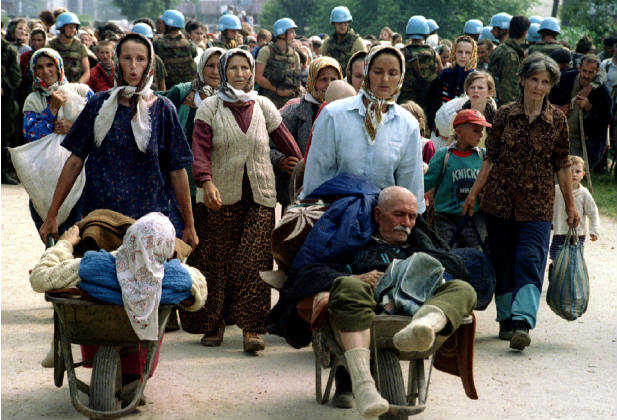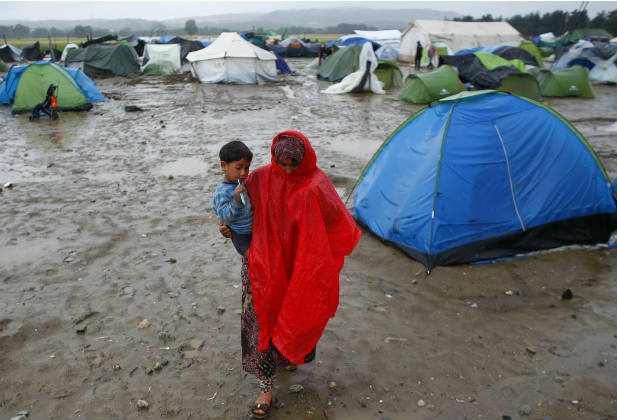 Displaced people from the minority Yazidi sect, fleeing violence from forces loyal to the Islamic State in Sinjar town, walk towards the Syrian border, August 10, 2014. REUTERS/Rodi Said
Displaced people from the minority Yazidi sect, fleeing violence from forces loyal to the Islamic State in Sinjar town, walk towards the Syrian border, August 10, 2014. REUTERS/Rodi Said
Share
The Trump Administration’s executive order on immigration indefinitely bars Syrian refugees from entering the United States, temporarily blocks citizens of seven Muslim-majority countries, and suspends all refugee admissions for 120 days.
This order comes at a time when over 65 million refugees and internally displaced persons (IDPs) worldwide have been uprooted from their homes. A disproportionate number of these refugees are women and children, many of whom face grave risks, from sexual violence and human trafficking to inadequate nutrition and healthcare. Of the 12 million people displaced by the current conflict in Syria, nearly two-thirds are women and children. In the United States, according to official State Department figures, over 78 percent of the Syrian refugees and 72 percent of all refugees admitted to the country as of 2016 were women or children.
In the wake of the Trump Administration’s immigration order, learn more about the history of U.S. and international policy to protect refugees—including women and children—around the world:
1948
United Nations Declaration of Human Rights
In December 1948, the newly-formed United Nations (UN) adopts the Universal Declaration of Human Rights, the first international document to assert “the dignity and worth of the human person and [the] equal rights of men and women.” Article 14 of the declaration recognizes the right of all persons to seek asylum from persecution.
1951
UN Convention Relating to the Status of Refugees
In the devastating aftermath of WWII, the 1951 Refugee Convention, ratified by 145 state parties, becomes a landmark legal document, defining the term ‘refugee’ and outlining the rights of the displaced as well as the legal obligations of all states to protect them. The convention establishes the principle of non-refoulement, reflecting an international consensus that it is unlawful to force refugees or asylum-seekers to return to a country in which they may be persecuted. While the U.S. government committed itself to implementing the principles of the convention, it would not formally ratify an international refugee framework until 1967.

Newly arrived refugees stand in their tent quarters at Beit Lid after arriving from Europe following the Nazi Holocaust of World War II. REUTERS
1967
UN Protocol Relating to the Status of Refugees
In October 1967, 146 countries sign on to a UN protocol on international refugees to expand the temporal and geographic scope of the 1951 convention, which previously focused on those displaced by the violence and genocide of WWII. The United States joined the international refugee regime by ratifying the protocol in Congress, by which it committed to co-operating with the Office of the United Nations High Commissioner for Refugees “or any other agency of the United Nations which may succeed it,” to applying the provisions of the protocol, and to communicating to the UN Secretary-General any new national laws or regulations that affect the application of the protocol.

Iraqi Kurdish refugees collect bread from a dirt road in Isikveren refugee camp in Turkey. REUTERS/Jim Hollander
1980
U.S. Refugee Act
Amidst mass migration of Vietnamese—many of whom had suffered years of imprisonment, discrimination, and sexual violence—the U.S. Refugee Act enacted in 1980 expanded the definition of a ‘refugee’ and founded the U.S. refugee resettlement program that exists today. Through the act, Congress signaled its intention to conform U.S. refugee law to international legal frameworks and established a permanent procedure for the admission of refugees of “special humanitarian concern.” The act raised the refugee cap from 17,400 to 50,000 people admitted each fiscal year and established the Office of U.S. Coordinator for Refugee Affairs and the Office of Refugee Resettlement. The act facilitated the United States’ acceptance of over 700,000 Vietnamese refugees—including tens of thousands of families—between 1975 and 1996.

The flag of former South Vietnam is draped over the shoulders of Vietnamese refugee Bai-Binh Ton-Thap as he stands next to 58,300 yellow ribbons tied to a fence surrounding the flight deck of the USS Midway as the ship commemorates the 40th Anniversary of the fall of Saigon. REUTERS/Mike Blake
1995
Dayton Accords
The General Framework Agreement for Peace in Bosnia and Herzegovina, also known as the Dayton Accords or Dayton Agreement, was formally signed by international parties to end the brutal three-and-a-half year Bosnian War, one of the Yugoslav Wars. The use of rape against Bosnian women and girls was widespread, and the International Criminal Tribunal for the former Yugoslavia would later declare that such “systematic rape” was a crime against humanity second only to the war crime of genocide. Over 700,000 people fled war-torn Yugoslavia for the EU, with 400,000 settling in Germany, and the U.S. began resettling large numbers of refugee families—primarily women and children—from Bosnia.

Aroup of Bosnian refugees from Srebrenica walk to be transported from eastern Bosnian village of Potocari to Kladanj, July 13, 1995. REUTERS
2016
UN Summit for Refugees and Migrants
In 2016, former U.S. President Barack Obama led efforts to hold a high-level summit on the margins of the 71st United Nations General Assembly meeting to address a growing international migration crisis, with the aim of bringing countries together behind a more just, efficient, and coordinated approach. Donor countries committed to a $4.5 billion total increase in global humanitarian financing—including a $1 billion increase by the United States. At the summit, 193 UN member states signed onto the New York Declaration, a plan to improve global response to movements of refugees and migrants. Numerous sessions addressed the heightened dangers faced by displaced women and children, such as significant health risks, forced marriage, trafficking, and sexual abuse.











